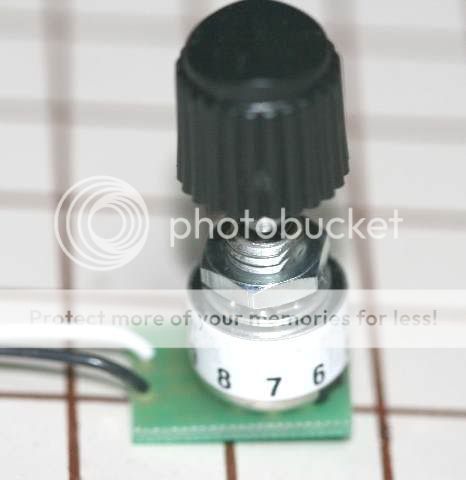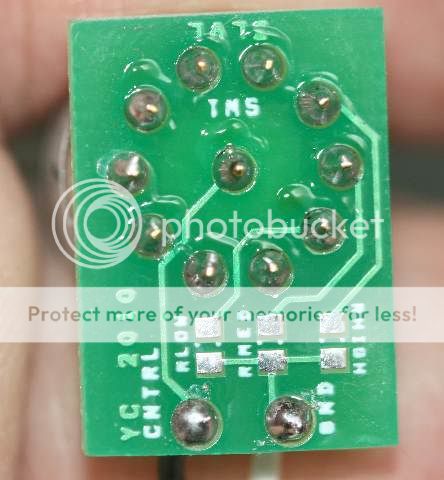I will be releasing this for sale on the shoppe when I get back from vacation.
If you recall there were a few threads discussing how to add external resistors to get multiple levels. To make it easier I made a board as shown below.

The rotary switch has stops set so there are only three positions for low, medium and high control. The two wires goto the two daughterboard holes in either Shark converter board. The bottomside contains the SMT resistors to set the brightness levels for the three positions. (trim pot removed and jumpered)

(No load RHIGH gives 100% output)
I will most likely offer a default configuration and also offer custom levels.
The switch orientation looking at the topside and orienting the wires to be at 12 o'clock, the medium setting is pointing to the right.

The D shaft accepts all 1/4" (0.25") press on and set screw type knobs. Since there are literally dozens and dozens of different knobs I will not be offering them with the product. I might sell the one shown as it is economically prices. The fancier knobs run anywhere from $8.00 to over $25.00 apiece depending on the shape and details of the knob. There are pointer style knobs, round knobs and round knobs with flange.
The rotary switch cost close to $10.00 so the unit price of the assembly will probably be in the range of $15.00 (TBD) without the knob. Knob sold seperately.
This is ideal for non flashlight applications like a bike light, fixed light such as a cree bar application since direct setting is the simpliest UI and most humans can figure out a knob brightness type control.
The other cool feature is you know before you turn on the power the brightness setting.
This is the simpliest UI possible.
There is another idea on the books. I could make a 4 position version and add a power MOSFET for power control. Then the settings would be:
OFF
LOW
MED
HIGH
With the 4 position version there would not be a need for a seperate power button. This is reminiscent of the early days tube/transistor radios where you would click on the volume control the turn the radio on.
I will consider the 4 position prototype after vacation especially if there is interest shown for it.
Wayne
If you recall there were a few threads discussing how to add external resistors to get multiple levels. To make it easier I made a board as shown below.

The rotary switch has stops set so there are only three positions for low, medium and high control. The two wires goto the two daughterboard holes in either Shark converter board. The bottomside contains the SMT resistors to set the brightness levels for the three positions. (trim pot removed and jumpered)

(No load RHIGH gives 100% output)
I will most likely offer a default configuration and also offer custom levels.
The switch orientation looking at the topside and orienting the wires to be at 12 o'clock, the medium setting is pointing to the right.

The D shaft accepts all 1/4" (0.25") press on and set screw type knobs. Since there are literally dozens and dozens of different knobs I will not be offering them with the product. I might sell the one shown as it is economically prices. The fancier knobs run anywhere from $8.00 to over $25.00 apiece depending on the shape and details of the knob. There are pointer style knobs, round knobs and round knobs with flange.
The rotary switch cost close to $10.00 so the unit price of the assembly will probably be in the range of $15.00 (TBD) without the knob. Knob sold seperately.
This is ideal for non flashlight applications like a bike light, fixed light such as a cree bar application since direct setting is the simpliest UI and most humans can figure out a knob brightness type control.
The other cool feature is you know before you turn on the power the brightness setting.
This is the simpliest UI possible.
There is another idea on the books. I could make a 4 position version and add a power MOSFET for power control. Then the settings would be:
OFF
LOW
MED
HIGH
With the 4 position version there would not be a need for a seperate power button. This is reminiscent of the early days tube/transistor radios where you would click on the volume control the turn the radio on.
I will consider the 4 position prototype after vacation especially if there is interest shown for it.
Wayne

